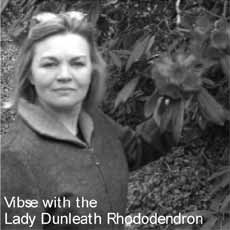|
|
In
the garden |
 |
|
by 1856, it has disappeared from
the map, to be replaced by the
more romantic style of landscaped
garden which remains today,
although many of the lime trees
that featured then remain only in
memory.
It seems fairly certain that it was
Andrew Mulholland, who built
Ballywalter House, who also
initiated the rhododendron
collection that the Park is so famed
for today, with a collection of large
hybrid rhododendrons. With ample
space for everything to grow, the
garden now boasts a superb
rhododendron collection, including
Rh Boddaertianum, a Rh
Johnstoneanum cross and Rh
Kyawii, a rarer member of the
Larishia subsection that
normally only grows in the
most favourable parts of the
world.
The crowning glory of the
rhododendron collection,
however, has to be the Rh Lady Dunleath, a hybrid
propagated by Lord Dunleath's great-grandfather
and only to be found in
Ballywalter Park. This is truly an
|
exceptional
plant, with stunning
deep red flowers unique in the
rhododendron world.
The walled garden at Ballywalter
must surely be a thing of envy for
many. Extending to roughly one
and a half acres, this haven of
growth is sheltered by a attractive
brick wall and features two ranges
of Victorian glasshouses dating to
the 1860's and a very attractive
pergola, which divides the garden
in two.
Much of this area is currently in
grass, but Vibse has a great many
plans for both the garden and the
glasshouses, which are currently
being restored.
"The glasshouses already contain
a collection of peach, apricot and
almond trees", she enthused, "and
both black and white grapevines,
planted, we believe, when the green
houses were first built. They still
yield a good crop of lovely muscat
grapes though."
"I'm planning to add to that
collection with lots of heirloom
vegetables that would have been
grown and used for food through
the ages." |
|
The pleasure
grounds at
Ballywalter extend to around
twenty acres. Although the garden
has always been planned
informally, to create long green
vistas from the house,
nevertheless, it is home to a
wonderful collection, particularly
of trees and shrubs.
Located on the relatively flat and
somewhat breezy Ards peninsula,
the tree planting around the
grounds provides essential
windbreaks and shelter, not only
for the pleasure ground, but also for
the estate's shoot. The framework
of the original garden takes the
form of a stand of beeches and oaks
planted around 1800. This planting
programme has been carried on by
generations of the Mulholland
family, not only around the
pleasure grounds, but throughout
the estate as a whole, where they
were necessary to create cover and
good flight paths for the shoot. The
tree collection at Ballywalter today
is superb, and includes a range of
broad leaves and conifers, including
a couple of Insignis Radiata reputed
to be the largest in Ireland and
possibly Europe.
Initially, the beech and oak
plantation framed a formal garden.
This may well have been swept
away in 'the big wind' of 1846, for, |
 |
|

